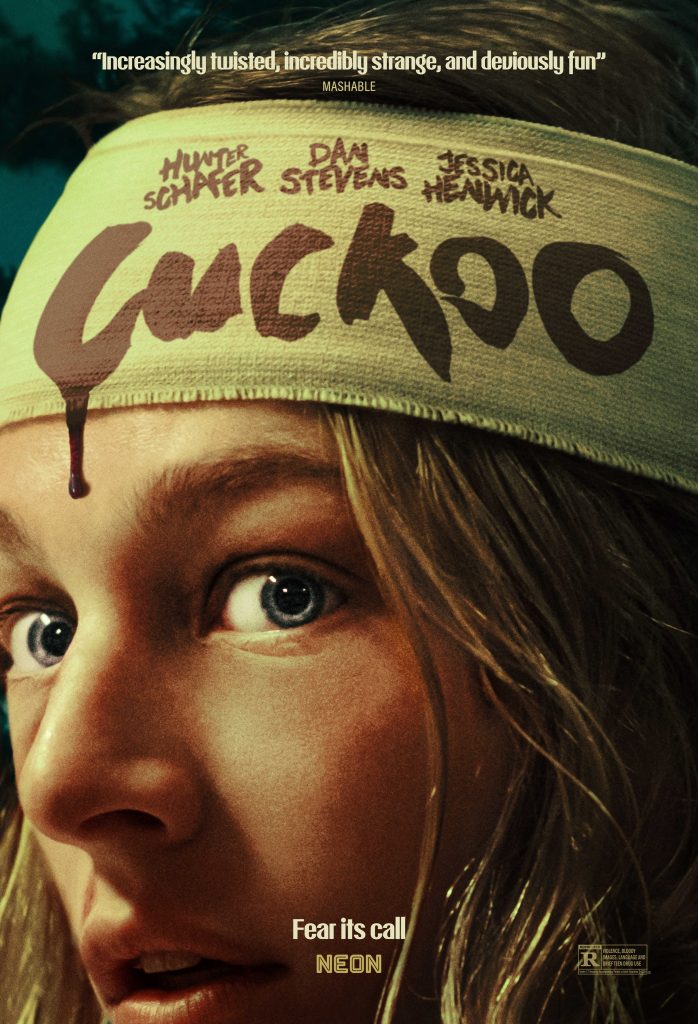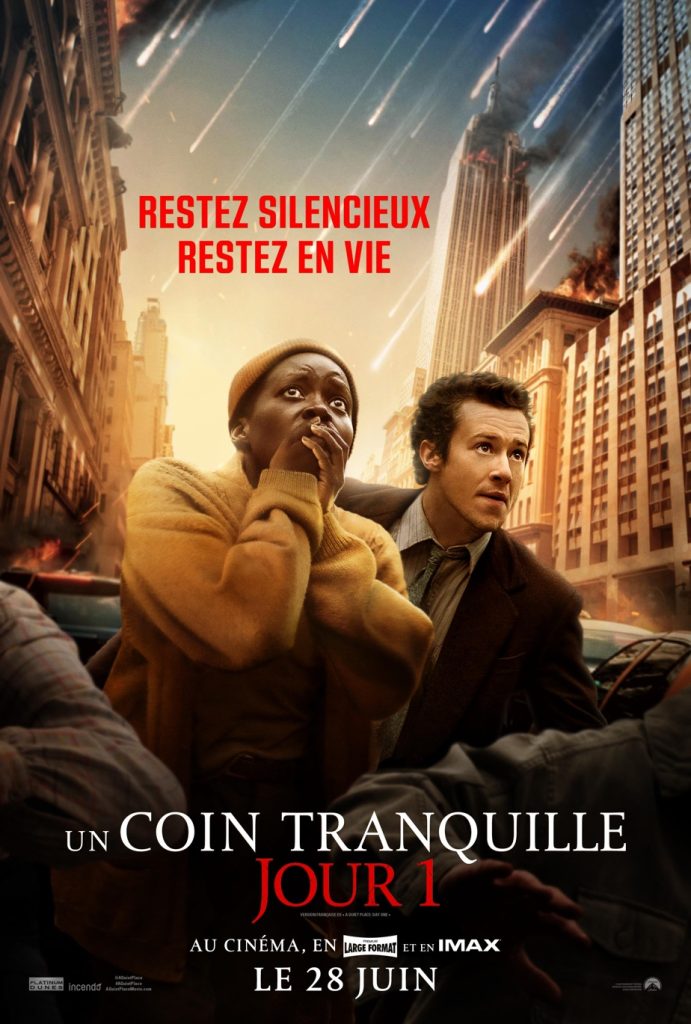Cuckoo
By Magdalena Nitchi

I went into Cuckoo relatively blind; all I knew from the trailer was that Hunter Schafer is the lead, and that the film includes some supernatural elements. If you are interested in watching it, then stop reading my review now. This is a thriller full of twists, and it’s best to let them unfold on the big screen.
After losing her mother, 17-year-old Gretchen moves in with her father Luis, stepmother Beth, and half-sister Alma. The family is moving into a resort in the Bavarian Alps; Luis and Beth are to build a hotel for the enigmatic Mr. König, and Alma, who is mute, will receive special treatments in the nearby hospital. Gretchen, resentful and eager to leave the town, soon notices that some things are not quite right in this seemingly-peaceful resort. Women appear dizzy and sick, disorienting ear-piercing shrieks come from the forest, and Alma begins having mysterious seizures.
As Gretchen investigates the area with the help of a policeman who is himself investigating a murder, she uncovers secrets about her parents, Mr. König, and even Alma’s medical issues that throw everything she knows into question. Stalked by a mysterious woman, Gretchen will have to play her cards right if she wants to survive.
The retro aesthetics of the small resort and lush Bavarian forests are the perfect backdrop for this film. The image of domestic and natural bliss that Gretchen’s family and Mr. König strive to portray render the horror lurking underneath all the more eerie. The unique biology and method of procreation of the film’s ‘monster’ hit on a visceral intersection of body horror and reproductive horror, with a dash of medical horror as well. Director Tilman Singer deftly creates the perfect unsettling combination that will leave the viewer both intrigued and uncomfortable.
Cuckoo feels like a love letter to 70s horror and thriller movies, and the heart poured into each actor’s performance helps sell even the more absurd plot elements. The twists in this movie are supremely executed; even when they were slightly predictable, Tilman built the tension in such a way that I was always on the edge of my seat. If you love modern horror with a retro feel and stories featuring twisted experiments, then this is the movie for you.
Un coin tranquille: Jour 1
Par Magdalena Nitchi

Un coin tranquille: Jour 1 est un film d’horreur apocalyptique qui se démarque du reste de la série Un coin tranquille en offrant aux spectateurs une histoire qui se déroule dans le même univers, mais cette fois-ci avec de nouveaux personnages. Le réalisateur Michael Sarnoski et le producteur et écrivain John Krasinski (qui a également écrit le premier film), nous transporte au tout début de l’apocalypse. Pour ceux qui ne sont pas familiers avec la franchise, dans cet univers, la Terre est soumise à une invasion extraterrestre. Ces prédateurs aveugles chassent à l’ouïe et sèment la terreur. Bien que le thème des extraterrestres envahissant New York ait déjà été exploré dans des films comme The Avengers (2012), la perspective originale du personnage principal y apporte un nouvel éclairage fascinant.
Jour 1 suit l’invasion extraterrestre à travers les yeux de Sam/Samira (Lupita Nyong’o), une patiente atteinte d’un cancer en phase terminale au tempérament pessimiste et sarcastique, qui se retrouve coincée au milieu de la ville. Alors qu’elle tente de protéger Frodon, son chat de thérapie, Sam rencontre Eric (Joseph Quinn), un étudiant en droit d’origine anglaise. Après plusieurs tentatives d’évacuations infructueuses, une amitié fragile se développe entre eux. Sam sait qu’elle mourra de toute façon, mais elle ne parvient pas à convaincre Eric de la quitter.
Même si on connaît le sort de Sam dès le début, l’histoire reste néanmoins très émouvante. Sarnosky et Krasinski équilibrent parfaitement les scènes d’actions et des moments plus doux, tels que Sam serrant Frodon dans ses bras, ou partageant avec Eric la poésie de son père décédé. Même dans les instants précédant la fin du monde, Jour 1 prend soin de montrer la beauté du monde, ce qui rend sa destruction encore plus poignante.
Si vous appréciez l’horreur teintée de douceur amère, une horreur qui embrasse à la fois la beauté et la tragédie de notre fragile existence, alors Un Coin tranquille: Jour 1 est fait pour vous. Plus que tout autre film de la franchise, ce préquel anime en profondeur ce que signifie la fin du monde à petite et à grande échelle, et comment les gens y font face. Le film est désormais disponible en version anglaise et française sur Paramount+.
Fire & Blood
By Olivia Shan

The finale of House of the Dragon’s painfully short second season, which aired earlier this August, has left me reaching for more content from George R. R. Martin’s world of Westeros. Fire and Blood, a prequel to Martin’s A Song of Ice and Fire series, is actually the first volume of a duology of books which relate the history of House Targaryen — the dragon-riding dynasty who ruled over Westeros for over three centuries — in exhaustive and effervescent detail. Fire and Blood covers the conquest of Westeros by the first Targaryen rulers, Aegon I and his sisters, and extends to the end of the royal civil war known as the Dance of the Dragons, from which House of The Dragon draws its main inspiration.
Diving headfirst into this fictional history book, I found myself pleasantly surprised by Martin’s confident narrative voice, which is marked by a deeply cinematic quality — unsurprising, considering the author’s considerable experience working in television. The addition of supplementary material such as a family tree, as well as the lovely black-and-white drawings by Doug Wheatley peppered throughout the book, definitely elevated my reading experience.
A blurb on my copy compares Fire and Blood to Tolkien’s The Silmarillion, but though both books elaborate on their respective fantasy worlds, their tone could not be more different. The Silmarillion’s grandeur and lyrical beauty is perhaps comparable to the King James Bible; Fire and Blood, for all its gleeful bloodiness, ultimately represents an entertaining pseudo-scholarly take on medieval historiography. Archmaester Gyldayn — the book’s fictional author — offers accounts from many primary sources, invariably tainted with gossip and fabrication. Gyldayn attempts (and often fails) to construct a more well-rounded perspective on the histories he presents. This especially becomes a point of contention in the section on the Dance of the Dragons, as recountings described by sympathizers of either warring faction — the Greens or the Blacks — diverge wildly; making it near impossible for Gyldayn (or the reader) to piece together an unbiased version of the truth. Even as someone who isn’t a die-hard Game of Thrones fan, I found this narrative approach deeply refreshing, and it obviously appeals to the history major in me.
I eagerly await the second volume of Fire and Blood, but in the meantime, A Song of Ice and Fire — tragically unfinished as it is — will doubtlessly feature in my reading for the coming months.
